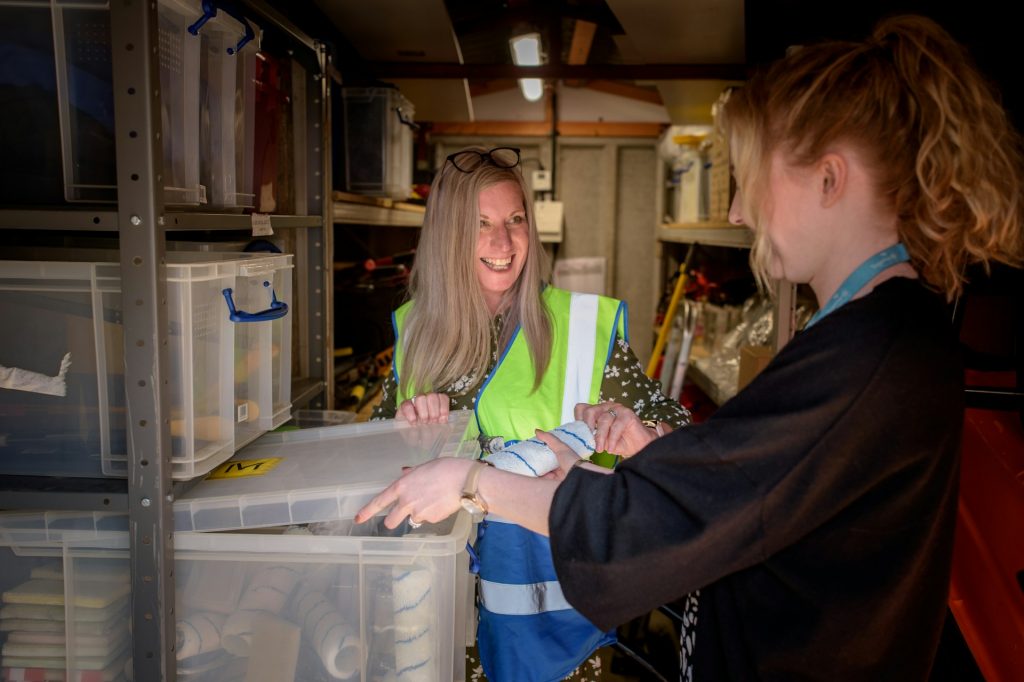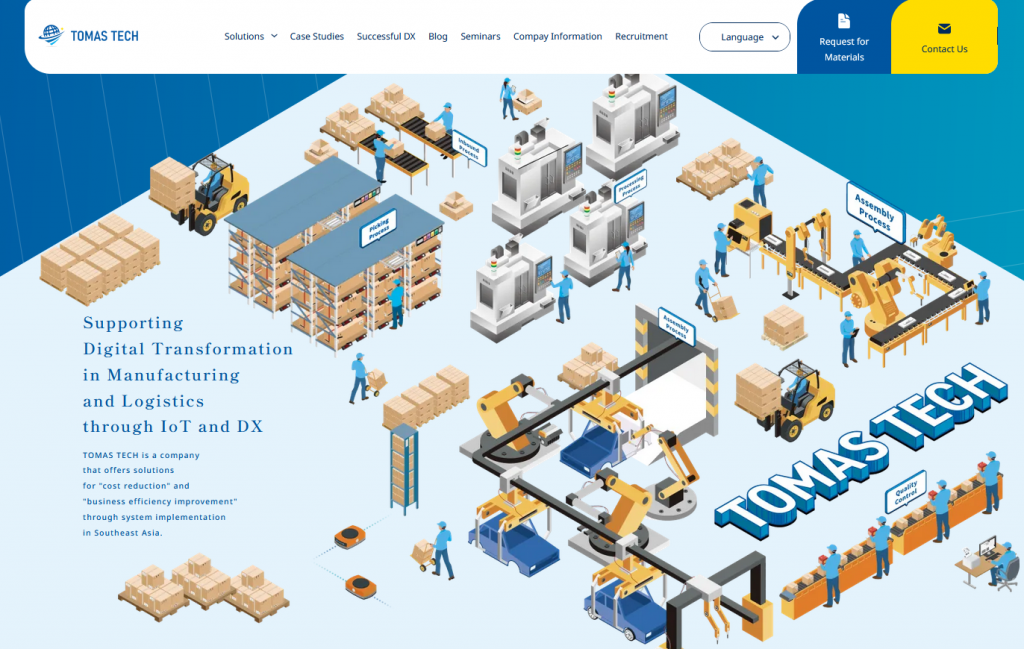Many Japanese companies operating factories and warehouses in Thailand face common inventory management challenges, such as “inventory discrepancies” and “time-consuming stocktaking.” While manual processes and paper-based operations remain deeply rooted, local operations increasingly demand visibility and efficiency. The key to solving these issues lies in implementing a Warehouse Management System (WMS).
This article provides a clear explanation of the benefits of WMS implementation tailored to Thai operations, step-by-step implementation procedures, and key success factors.
Common Inventory Management Challenges in Thailand

Let’s begin by outlining the typical challenges faced when managing inventory systems in Thailand.
Inventory Discrepancies and Burdensome Stocktaking
Manual tracking using Excel often results in mismatches between recorded and actual stock. Errors due to missed entries, transcription mistakes, and human miscounts can create gaps between system data and physical inventory.
To correct these discrepancies, many companies conduct monthly stocktaking, which is a heavy burden. Due to workforce limitations in Thailand, stocktaking frequently requires overtime and work on holidays. Despite spending considerable time and manpower, companies still struggle with inventory mismatches, affecting production planning and shipping schedules.
Inefficiency due to Reliance on Individuals and Paper-based Management
Inventory processes often rely on specific individuals, depending on their experience and intuition. Some local Thai staff have memorized storage locations and quantities based on years of experience, which poses risks if those individuals are absent. Paper records and ad hoc Excel sheets are still commonly used, causing delayed information sharing and frequent errors. Combined, these factors lead to inefficiencies and unshared real-time data.
Lack of Inventory Visibility due to Fragmented Data
If your Thai operations involve multiple factories or departments with different management systems, inventory data becomes fragmented. For example, if finished goods and parts are tracked separately or if the system in Thailand isn’t integrated with the headquarters in Japan, it’s hard to get a complete picture. As a result, it’s difficult to grasp inventory status at a glance, causing overstocking, stockouts, emergency shipping, increased costs, and lost business opportunities.
Key Improvements of WMS Implementation

Here are three major improvements that WMS implementation can bring:
Accurate Inventory “Visualization” Reduces Errors
With a WMS, data is immediately updated for each incoming and outgoing shipment, providing a constant and accurate visualization of inventory counts. By utilizing barcode scanning, etc., errors caused by handwritten or visual checks are greatly reduced, and discrepancies between the ledger and actual inventory are eliminated. When data is accurate in real time, there is no need to waste time checking with the warehouse each time because you are not sure if the inventory is correct.
As a result, shipping errors and delays are prevented, and the risk of loss of credibility is reduced. In addition, the frequency of monthly inventories can be reduced if inventory accuracy is improved. In fact, in some cases, the introduction of the system has reduced inventory from once a month to about once every six months, leading to a significant reduction in both on-site workload and costs.
Standardized Processes and Increased Efficiency
By standardizing the workflow of inventory management through the introduction of a WMS, work can be performed with the same quality no matter who is in charge. For example, since the system guides a series of procedures from receiving to shelving and picking (delivery), even inexperienced staff can carry out their tasks without making mistakes.
The system reduces the amount of work that relies on tacit knowledge and intuition, which had become the province of the individual, and shortens work time by following standardized procedures. In addition, time spent on handwriting and Excel input is no longer necessary, dramatically improving operational efficiency. For example, if picking lists that were previously distributed on paper can now be checked and input on a handy terminal, the time and effort of searching for and retyping the lists can be eliminated. The introduction of the system can realize speed improvement and reduction of human error while leveling the work on site.
Utilize Data and Maintain Appropriate Inventory
WMS will accumulate inventory data from the past to the present. This data facilitates analysis of demand fluctuations and the pace of delivery of each item, and helps in strategies to maintain appropriate inventory levels. So-called “appropriate inventory” is the optimal level of inventory that is neither too much nor too little.
Once the system is in place, you can monitor indicators such as inventory turnover and frequency of shortages to prevent stock-outs of hot-selling products and reduce immobile inventory (slow-moving inventory). Furthermore, since inventory information is centralized and management can share the data, it will be easier to coordinate inventory policies between the Thai base and the head office in Japan. By shifting to data-based inventory management, the company will be able to move away from the traditional approach of relying on intuition and experience, and will be able to make well-reasoned order and production plans, resulting in improved efficiency and profitability of the entire operation.
Steps to Implement an Inventory Management System in Thailand

The following section describes the steps for implementing an inventory management system in Thailand.
On-site Assessment and Visualization of Issues
The first step is to conduct an on-site survey to identify current business processes and issues. Interviews are conducted with both the Japanese manager and the Thai person in charge to visualize the problems in inventory management. We will confirm in detail what procedures are currently used for receiving, shipping, and inventory, where discrepancies in inventory counts are occurring, and whether there are any tasks that have been assigned to specific individuals.
In addition, we will also investigate the IT literacy of local staff and language issues (e.g., whether the system needs to display Thai rather than Japanese). It is important to make a list of specific issues and share it with management. For example, “The numbers on the inventory list are unreliable, so they have to be recounted on site,” or “There are products for which only person A in charge knows the location. By taking this step of understanding the current situation, accurate information can be connected to the next step of defining system requirements.
System Requirements Definition and Design
Once the current issues are clarified, the requirements and design of the system that will solve them are defined. In defining requirements, we organize the functions and conditions required for the system, such as “barcode management to eliminate inventory discrepancies,” “Thai-language screens for ease of use by Thai staff,” and “data linkage with the head office ERP to prevent double entry of data.
When identifying the necessary functions, it is also important not to seek excessively high functionality from the outset. By first narrowing down the list to the functions that are truly necessary for your company and avoiding over-specification, you can reduce unnecessary costs and complexity. Once the requirements have been established, proceed to the basic design of the system that will realize them. If an off-the-shelf WMS package is to be utilized, we will examine the settings and customization items to suit the company’s operations.
On the hardware side, the plan includes the selection of necessary equipment such as barcode readers and inventory terminals, as well as the development of a wireless LAN environment. A phased introduction plan (e.g., test introduction in some warehouses first, and if there are no problems, then roll out to the entire operation) will also be drafted at this stage.
System Implementation and Rollout
Once a system that meets the requirements has been prepared, it is time for the system implementation phase. First, we will check the operation of the system in a test environment and conduct a trial operation with on-site personnel. For Thai staff, we will provide language-aware training (including preparation of Thai-language manuals and demonstration explanations) and carefully familiarize them with the operating procedures.
In the initial stage of introduction, pilot introduction of system input in parallel with existing operations is also effective. Starting with a small number of warehouses or specific product categories and gradually expanding the scope of application of the system will minimize confusion in the field. For example, “First, we will operate the WMS in Warehouse A, and based on the improvements made in Warehouse A, we will expand the system to Warehouses B and C.” This is a step-by-step development.
At the time of implementation, Japanese staff and Thai staff cooperate with each other to establish the system in line with actual operations. Initial tasks such as barcode labeling and shelf number (location) registration will be performed in a planned manner, with the goal of having the basic functions up and running in a short period of time. A follow-up system will be put in place, with IT staff standing by onsite to ensure immediate recovery in the unlikely event of a problem.
Establishment and Operational Follow-up
Establishment and operational follow-up after system implementation is another important step that must not be forgotten. Immediately after a new inventory management system is installed, the field staff may not be accustomed to using it and may try to revert to the old way of doing things, or they may not be able to use some of the functions.
For the first few months after the system is implemented, we will monitor the operational status at the site and confirm that the established operational flow is being followed. If there are any deviations from the rules or errors, we will conduct another training session and patiently explain why it is necessary to follow the new flow and that it will ultimately make their work easier if they do not skip system input. It is also effective to post operation manuals on site as necessary, reassign veteran staff with low motivation to other tasks, and actively recruit personnel who are willing to utilize IT.
Strengths of TOMAS TECH’s Support (consistent support from on-site survey to settlement)

Local Assessment
Bilingual staff (Japanese/Thai) conduct on-site surveys and identify local-specific issues through direct interviews.
System Design
Propose inventory solutions tailored to local processes, including multilingual UI and integration with legacy systems.
Implementation Support
Offer in-person training, act as liaison between Japanese and Thai staff, and ensure smooth phased deployment.
Adoption Support
After the system is implemented, we closely follow up with the client. We monitor the operational status of the system, suggest improvements, and provide ongoing support, including the introduction of additional functions and support for human resource development.
TOMAS TECH’s strength lies in its ability to provide a one-stop shop for these services.
Frequently Asked Questions about Implementing a WMS in Thailand

Q: I’m worried about suddenly installing on a large scale. Can we try it on a small scale?
Yes, you can. We recommend starting on a small scale with a few processes or warehouses, and expanding in stages after confirming that the system can be operated without any problems. Pilot implementation allows us to verify the effectiveness of the system while alleviating on-site concerns.
Can Thai staff operate the system independently? (Language support, etc.)
Absolutely. TOMAS TECH provides training support in both Japanese and Thai languages to assist local staff in running the system on their own.
How much does it cost to implement the WMS?
It depends on the scale of the factory, the scope of management, and the system type. In some cases, you can start with a monthly fee when using a commercial cloud WMS, while initial development costs will be incurred when customizing the system for your company. Please feel free to consult with us so that we can first propose the best plan for your budget and needs.
Conclusion: Gradual Systemization is Key to Inventory Improvement in Thailand
Issues like inaccurate stock levels and individual dependency can be solved with proper steps. Rather than jumping into a fully advanced system, success lies in gradually systemizing local operations.
Start by visualizing on-site challenges and proceed step-by-step at a manageable pace. When in doubt, turn to experts who understand local conditions. TOMAS TECH will support your Thai inventory management from assessment to adoption. Please feel free to reach out to us anytime.



